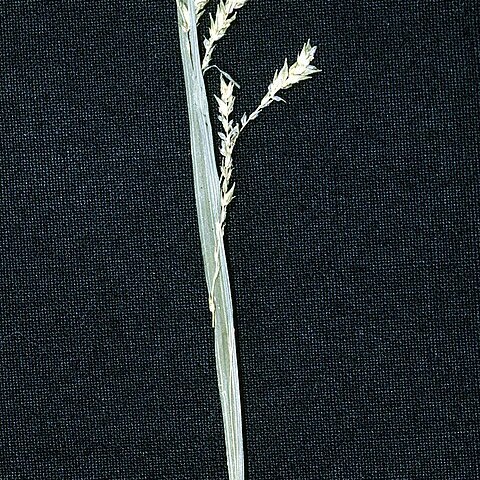Plants densely cespitose. Culms green or slightly suffused with maroon at base; flowering stems 30–80 cm, usually longer than leaves at maturity, 0.8–1.1 mm thick, glabrous but finely scabrous on angles within inflorescence. Leaves: basal sheaths 2–3, green or tinged with maroon, bladeless, very short or absent, glabrous; others green on back, white-hyaline on front; blades flat, 2–5 mm wide, glabrous. Inflorescences: peduncles of lateral spikes slender, to 4 cm, mostly shorter and usually shorter than spikes, glabrous; peduncle of terminal spike less than 10 mm, minutely scabrous; proximal bracts equaling or exceeding inflorescences; sheaths less than 3 mm; blades 2–3 mm wide. Lateral spikes 2–4, 1 per node, each overlapping 1 above, uncrowded, nodding or drooping at maturity, pistillate with 25–50 perigynia, narrowly cylindric but broader and more densely flowered at distal end (flowers 1 mm apart) than proximal end (flowers 3.5 mm apart), 15–60 × 3.5–5.5 mm. Terminal spike staminate or gynecandrous with a few pistillate flowers distally, 25–40 × 2.5–4 mm. Pistillate scales white-hyaline with broad green midrib, ovate-oblong, shorter than mature perigynia, apex cuspidate or with green awn about as long as body of scales, scabrous at tip, otherwise glabrous. Perigynia green to golden green at maturity, strongly 2-ribbed but otherwise veinless or nearly so, loosely enveloping achene, lance-ovoid, 2.5–4 × 1–1.5 mm, membranous, base with short stipe, apex tapering to flattened, often bent beak, glabrous; beak 1–1.5 mm, with minute hyaline teeth. Achenes substipitate, 1.3–2 × 1–1.2 mm. 2n = 60.
More
Tufted, 3–8 dm, brown or greenish at base; main lvs 3–5 mm wide; sheaths glabrous; terminal spike staminate or with a few apical perigynia; pistillate spikes 2–4, widely separated, cylindric, 2–5 cm, 5 mm thick, curved or nodding, the lower on long peduncles, the upper on much shorter ones; upper bract sheathless or nearly so; pistillate scales ovate to obovate-oblong, shorter than the perigynia, mucronate or short-cuspidate; perigynia 2.9–4.2 mm, rhombic-ovoid, trigonous, sharply angled at the prominent lateral ribs, obtusely angled on the back, otherwise essentially nerveless, tapering to an acute, at first nearly flat, later trigonous beak; achene concavely trigonous. Moist or wet woods and streambanks; Que. and Me. to Mich., s. to S.C., Ga., and Ala.


